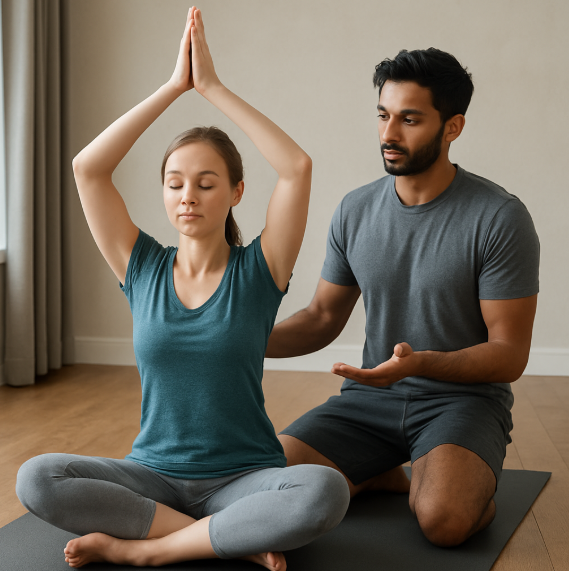Table of Contents
A beginning that wasn’t pretty
The first time I tried yoga, I followed a free video on my living-room floor and immediately discovered two things: my hamstrings were dramatic and my balance had a sense of humor. I spent most of the class staring at my own knees, trying to remember which foot was left, and wondering if breathing “into my ribs” was a real instruction or a metaphor I wasn’t spiritually mature enough to understand. Still, when I lay down at the end, something softened. My shoulders which usually live somewhere near my ears dropped. My jaw unclenched. For five quiet minutes, I felt like I had stepped out of the weather inside my head. That small shift was enough to bring me back the next day, and the next. Not because I was good at yoga, but because for the first time in a long time, I felt like my body and I were on the same team.
What “beginner” really looks like
Being a beginner is not glamorous. It’s micro-adjustments and wobbling and realizing half your tension is coming from trying to “do it right.” I had to let myself be new, which is harder than it sounds. Some days I felt clumsy. Some days I felt strong. Most days I felt both within ten minutes. Yoga met me where I was tight hips, busy mind, zero mystical insight and whispered, keep breathing. Once I stopped trying to win at the poses and started listening to what they were asking of me, everything changed. Flexibility became less of a destination and more of a conversation. Balance turned into a practice of noticing. Peace showed up in the pauses between my inhales and exhales.
Flexibility arrives quietly
If you’re starting stiff, you’re not broken you’re human. My hamstrings used to light up at the mere suggestion of a forward fold. Progress wasn’t dramatic; it was ordinary and faithful. I learned to back off a little before the edge, hold my breath steady, and let time do its quiet work. Weeks later, I realized my fingertips were grazing the mat. A month after that, my low back felt less cranky when I sat at my desk. Flexibility arrived the way dawn arrives so gradually you don’t notice it until the room is full of light.
Balance is a conversation, not a statue
Tree pose once looked like a dare to me. I’d plant my foot, glue my gaze to a spot on the wall, and inevitably tip. Then a teacher said, “Let the ankle wobble; that’s your strength waking up.” Suddenly, balance wasn’t failure or success. It was my body negotiating with gravity, one heartbeat at a time. On days I felt scattered, I took that lesson off the mat. I paused before answering the stressful email. I breathed before replying to the text. Balance stopped being an achievement and became a way to move through the world.
Breath: the hidden engine
Breath is the part of yoga you can’t photograph but always feel. When I rushed it, every pose felt like effort. When I matched movement to breath lift on inhale, soften on exhale my body organized itself. The breath gave rhythm to the work and kindness to the edges. On anxious mornings, I would sit for sixty seconds and count four in, six out. It didn’t fix my life, but it made the moment livable, which is often enough.
Mountain Pose (Tadasana)
This is where I learned that standing can be an action. I placed my feet hip-width, spread my toes, and felt the quiet intelligence of the floor. Knees soft, tail heavy, crown lifting suddenly I was taller, not because I strained, but because I stacked myself like a set of patient building blocks. When the day pulled me in five directions, coming back to Mountain reminded me that steadiness isn’t a mood; it’s a posture I can inhabit.
Child’s Pose (Balasana)
When I first discovered I could rest in the middle of a class, I almost cried. Knees wide, big toes touching, forehead to the mat, arms forward or tucked back by the heels Child’s Pose became my honest place. If my breath turned jagged or my thoughts ran ahead, I came here and let the ground carry me. In a culture that bows down to grind, a posture dedicated to softening felt quietly rebellious.
Downward Dog (Adho Mukha Svanasana)
Downward Dog humbled me. My heels hovered, my shoulders complained, and my wrists filed a formal protest. Then I learned to bend my knees, tilt my tailbone, and press more through my fingertips. It turned from a punishment into a long exhale for my back body. On good days it felt like a triangle of possibility: hands anchoring what I could control, hips lifting what I could hope for, heels slowly migrating toward a future I didn’t have to rush.
Low Lunge (Anjaneyasana)
This pose is the door I open when my hips feel like old, stubborn stories. I stepped one foot forward, slid the back knee down, and let my pelvis drift a breath at a time. When I added an arm sweep or a gentle side bend, I could almost hear the psoas unclasping. Low Lunge taught me patience with deep places. The release didn’t come from forcing, but from being willing to stay and listen.
A gentle flow you can repeat in real life
When time is tight, I stitch these shapes together like a pocket-sized ritual. I stand tall in Mountain and choose to arrive. I warm my spine with a few rounds of Cat–Cow until my breath and body are in the same conversation. I fold into Child’s Pose to remember that rest is allowed. I press back to Downward Dog and let the back line of my body wake up. I step into Low Lunge on each side to unstick the hips that carry my day. I stand into Tree to practice being steady without being rigid. I sit for Seated Forward Fold and practice meeting my edge with patience. I lift into Bridge to open what hours of sitting have closed. I finish in Savasana and let the stillness do what only stillness can. Ten to twenty minutes, no perfection required, just presence.
Making it fit a real week
I don’t live in a world where I can unroll my mat for ninety minutes every morning. Most weeks, I practice in scraps: ten minutes before coffee, seven minutes between emails, fifteen in the evening when my brain feels fried. The trick was lowering the threshold. If I asked myself for a lot, I did nothing. If I asked for a little, I often did more. On messy days, my practice was three long breaths in Mountain and two rounds of Cat–Cow. On better days, I wandered through the whole flow and lost track of time. Both kinds of days moved the needle, because consistency is a form of faithfulness.
Soreness, safety, and pacing
Being new meant meeting soreness. Not the sharp kind if it’s sharp, I back out but the honest ache that arrives when sleepy muscles remember their jobs. Props helped. I sat on a blanket to tip my pelvis forward, used books when I lacked blocks, and bent my knees without apology. I learned that “no pain, no gain” is not yoga’s voice. Yoga says, “Stay curious, not heroic.” I also learned that rest days are part of training, that hydration is quiet medicine, and that sleep makes every pose kinder.
When motivation dips
Motivation isn’t a reliable friend. On the days it ghosted me, I leaned on ritual instead. I kept my mat visible, set a tiny cue like lighting a candle, and pressed play on the same two songs that my body now associates with returning. I promised myself five minutes. Often, momentum did the rest. And when it didn’t, five minutes of breathing still counted. The honest truth is that every practice teaches me how to begin again, which turns out to be the whole skill of being human.
How yoga changed things off the mat
The poses made my body more forgiving fewer desk aches, steadier ankles, kinder hips but the real gifts showed up in places no one could see. I noticed myself pausing before reacting. I apologized faster. I took three breaths before opening difficult emails. I found that I could feel the surge of anxiety and still choose a slower answer. Yoga didn’t make my life easy; it made me a little less brittle inside it.
An invitation to start where you are
If you’re waiting to feel flexible, coordinated, or serene before you start, you’ll wait forever. Begin as you are in the body you have, on the floor you have, with the breath you already carry. Let Mountain remind you that standing is an art. Let Cat–Cow teach your spine to be a river again. Let Child’s Pose bless your effort with rest. Let Downward Dog be your patient project, Low Lunge your hip whisperer, Tree your gentle bravery, Forward Fold your humility, Bridge your unbuttoning, and Savasana your surrender. None of it needs to be perfect. All of it counts.
If you meet yourself on the mat a few imperfect minutes at a time, flexibility will arrive without drama, balance will feel less like a test and more like a conversation, and peace will stop being a destination and become a place you visit every day. When you’re ready, roll out the mat. When you’re not, take one slow breath and call that practice. Either way, you’ve begun.



